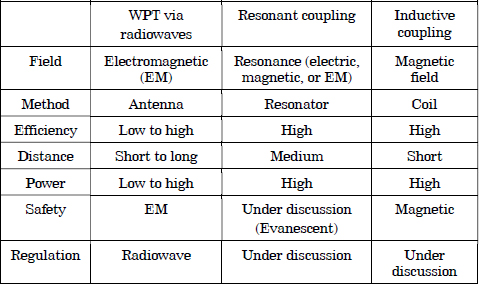Wireless power transfer (WPT) is a promising technology based on electromagnetic theory and radiowave theory, representing the combined application of electrical and radio sciences. There are numerous WPT technologies, such as inductive coupling WPT (Figure I.1(a)) and resonant coupling WPT (Figure I.1(b)) as short distance WPT. In addition, WPT via radiowaves has been developed as a long-distance WPT technology, which includes focused beam microwave power transfer (MPT) (Figure I.1(c)) and energy harvesting from broadcasted radiowaves or diffused wireless power (Figure I.1(d)). Both inductive coupling WPT and resonant coupling WPT are based on electromagnetic theory. A transmitter and a receiver are electromagnetically coupled and power is wirelessly transmitted via an electric field, a magnetic field, or an electromagnetic field. Unlike the short-range technologies, WPT via radiowaves does not require coupling between the transmitter and the receiver, but it uses radiated electromagnetic waves. WPT via radiowaves requires higher frequencies, such as microwaves, to focus on the wireless power effectively. The general characteristics of various WPT technologies are described in Table I.1. The primary difference between inductive and resonant coupling is the presence of non-resonance and resonance, respectively. In the case of short distances, inductive or resonant coupling technologies using coils are effective, but the coupling distance is limited by coupling theory even for resonant coupling. To expand the distance over which power can be transferred, radiowaves are necessary to carry the energy. For WPT via radiowaves, antennas are used for power radiation and receiving. The antenna serves as a resonator to radiate radiowaves effectively.
Figure I.1. Various WPT technologies: a) inductive coupling, b) resonant coupling, c) WPT via focused beam radiowaves and d) energy harvesting via diffused radiowaves

Table I.1. Characteristics of WPT technologies

All WPT technologies are based on Maxwell’s equations. However, there are minor differences in their applications. It is now possible to use higher frequency radiowaves, for example in the gigahertz (GHz) range of microwaves, to focus on electric power wirelessly at sufficient levels and on beam efficiency to satisfy the needs of many applications. A WPT system is shown in Figure I.2. Frequency converters are used to transform electricity into wireless power, and vice versa. The primary difference between electricity and wireless power is only a matter of the frequency. It is also possible to transmit wireless power from multitransmitting antennas to multireceiving antennas like broadcasting and wireless communications because the antennas are not coupled electromagnetically. Very low power WPT systems do not even require battery storage and can be run on the energy harvested from ambient radio frequency (RF) and microwave radiation. Additionally, the extent of battery storage can be reduced when wireless power is widespread because batteries can be charged wirelessly and, hence, shortages of battery storage are not a concern.
Figure I.2. A WPT system

This scenario will soon be a reality. WPT via radiowaves is, in fact, a valuable and convenient technology that can be used to charge batteries in mobile phones, notebook personal computers (PCs), electric vehicles (EVs), as well as battery storage for light emitting diodes (LEDs), integrated circuits (ICs) and other equipment. In the near future, stable CO2-free electric power from space will be possible using WPT technology. The concept of a space-based solar power satellite (SPS) is supported by MPT. The SPS is a gigantic power station built in space. The SPS is a primary system of significance to the concept of the “humanosphere”. The humanosphere concept corresponds to the description of Earth as a space where human activity takes place. Humanospheric science is defined as an interdisciplinary science that conducts research concerning the humanosphere. This science is a significant development for the future of the human race. A pictographic description of the humanosphere and humanospheric science is shown in Figure I.3. To maintain human welfare and the current standard of living, or even to avoid disaster during this century, the issues of energy, food and the environment should be seriously addressed. Presently, the increasing demand for electricity conflicts with the demand for a clean environment due to the use of fossil-based power production. Electricity has heretofore been generated through various methods, such as hydroelectric power, fossil thermal power and atomic power. However, some of these methods are causes of environmental and pollution issues all over the world. Under these circumstances, research has been carried out to investigate the possibility of building power stations in space to transmit electricity, generated in space, to the Earth via radiowaves. It is believed that WPT technologies support this vision of a bright future.
Figure I.3. A pictographic description of the “humanosphere” and humanospheric science

